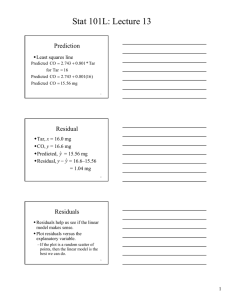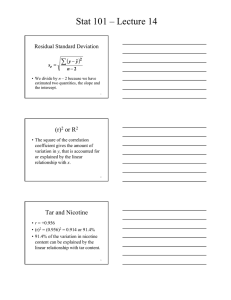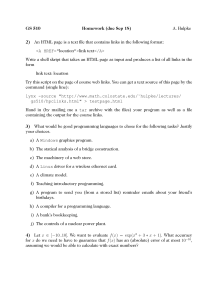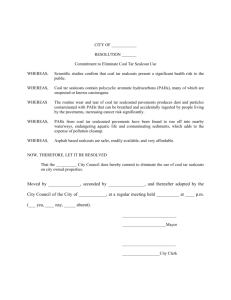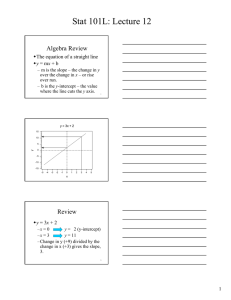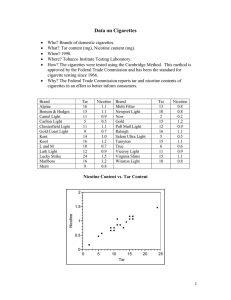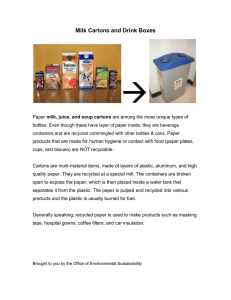International Journal of Application or Innovation in Engineering & Management... Web Site: www.ijaiem.org Email: , Volume 2, Issue 12, December 2013
advertisement
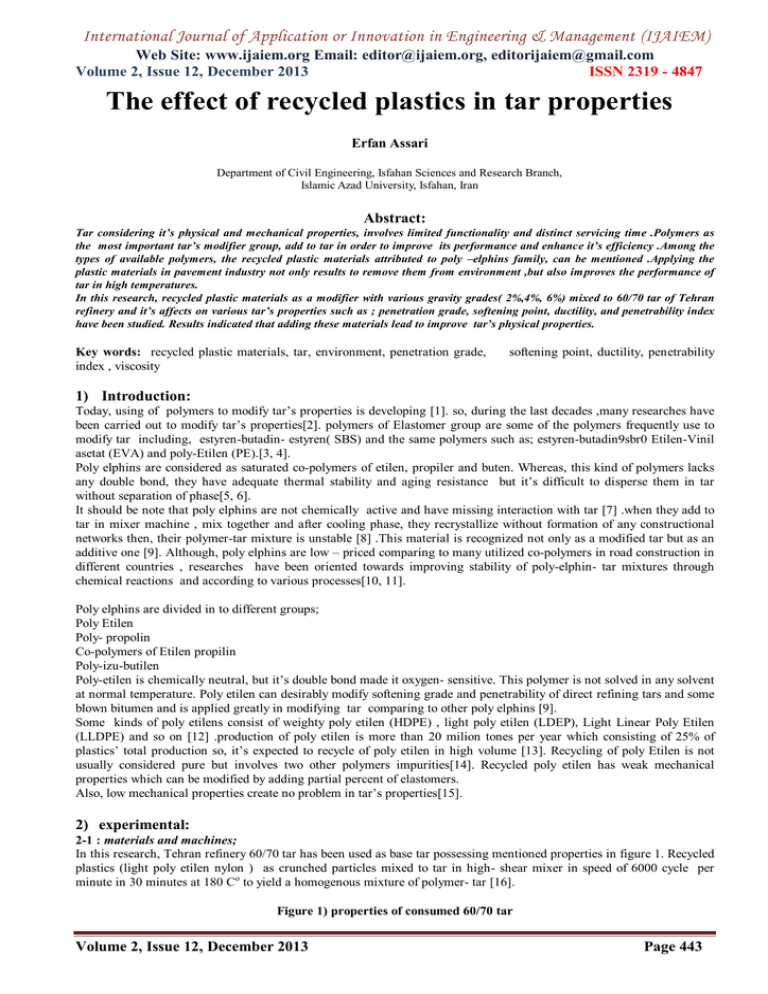
International Journal of Application or Innovation in Engineering & Management (IJAIEM) Web Site: www.ijaiem.org Email: editor@ijaiem.org, editorijaiem@gmail.com Volume 2, Issue 12, December 2013 ISSN 2319 - 4847 The effect of recycled plastics in tar properties Erfan Assari Department of Civil Engineering, Isfahan Sciences and Research Branch, Islamic Azad University, Isfahan, Iran Abstract: Tar considering it’s physical and mechanical properties, involves limited functionality and distinct servicing time .Polymers as the most important tar’s modifier group, add to tar in order to improve its performance and enhance it’s efficiency .Among the types of available polymers, the recycled plastic materials attributed to poly –elphins family, can be mentioned .Applying the plastic materials in pavement industry not only results to remove them from environment ,but also improves the performance of tar in high temperatures. In this research, recycled plastic materials as a modifier with various gravity grades( 2%,4%, 6%) mixed to 60/70 tar of Tehran refinery and it’s affects on various tar’s properties such as ; penetration grade, softening point, ductility, and penetrability index have been studied. Results indicated that adding these materials lead to improve tar’s physical properties. Key words: recycled plastic materials, tar, environment, penetration grade, index , viscosity softening point, ductility, penetrability 1) Introduction: Today, using of polymers to modify tar’s properties is developing [1]. so, during the last decades ,many researches have been carried out to modify tar’s properties[2]. polymers of Elastomer group are some of the polymers frequently use to modify tar including, estyren-butadin- estyren( SBS) and the same polymers such as; estyren-butadin9sbr0 Etilen-Vinil asetat (EVA) and poly-Etilen (PE).[3, 4]. Poly elphins are considered as saturated co-polymers of etilen, propiler and buten. Whereas, this kind of polymers lacks any double bond, they have adequate thermal stability and aging resistance but it’s difficult to disperse them in tar without separation of phase[5, 6]. It should be note that poly elphins are not chemically active and have missing interaction with tar [7] .when they add to tar in mixer machine , mix together and after cooling phase, they recrystallize without formation of any constructional networks then, their polymer-tar mixture is unstable [8] .This material is recognized not only as a modified tar but as an additive one [9]. Although, poly elphins are low – priced comparing to many utilized co-polymers in road construction in different countries , researches have been oriented towards improving stability of poly-elphin- tar mixtures through chemical reactions and according to various processes[10, 11]. Poly elphins are divided in to different groups; Poly Etilen Poly- propolin Co-polymers of Etilen propilin Poly-izu-butilen Poly-etilen is chemically neutral, but it’s double bond made it oxygen- sensitive. This polymer is not solved in any solvent at normal temperature. Poly etilen can desirably modify softening grade and penetrability of direct refining tars and some blown bitumen and is applied greatly in modifying tar comparing to other poly elphins [9]. Some kinds of poly etilens consist of weighty poly etilen (HDPE) , light poly etilen (LDEP), Light Linear Poly Etilen (LLDPE) and so on [12] .production of poly etilen is more than 20 milion tones per year which consisting of 25% of plastics’ total production so, it’s expected to recycle of poly etilen in high volume [13]. Recycling of poly Etilen is not usually considered pure but involves two other polymers impurities[14]. Recycled poly etilen has weak mechanical properties which can be modified by adding partial percent of elastomers. Also, low mechanical properties create no problem in tar’s properties[15]. 2) experimental: 2-1 : materials and machines; In this research, Tehran refinery 60/70 tar has been used as base tar possessing mentioned properties in figure 1. Recycled plastics (light poly etilen nylon ) as crunched particles mixed to tar in high- shear mixer in speed of 6000 cycle per minute in 30 minutes at 180 Co to yield a homogenous mixture of polymer- tar [16]. Figure 1) properties of consumed 60/70 tar Volume 2, Issue 12, December 2013 Page 443 International Journal of Application or Innovation in Engineering & Management (IJAIEM) Web Site: www.ijaiem.org Email: editor@ijaiem.org, editorijaiem@gmail.com Volume 2, Issue 12, December 2013 ISSN 2319 - 4847 Ductility (cm) 100 Softening point (c0) 51 Penetration grade 66 Density (g3/cm) 10/3 manufacturer Tehran refinery Type of tar 60/70 3) Methods: On the one hand, tendency to high temperature to reduce viscosity and reach to appropriate blending and ,on the other hand, increasing speed of polymer demolition in high temperatures have been limited the blending area to 180 C0 <T mix < 200 C 0 [4]. method of Blending in mixer was as follows; at first, tar heated to 150 C0 ,then the recycled crunched plastic materials mixed to tar within 10 min in high speed 3000 rmp in order to initially blend the tar and polymer and initial formed network of polymer in tar prevent changing it’s properties as a result of increasing temperature to mix secondarily. Then, tar’s temperature reached to 180 C0 and mixed to the recycled plastics in high speed ( rmp 6000). 4) discussions; In providing tar’s samples ,recycled plastic materials which about 90-95% of them are light poly etilel polymers ( used nylon pockets in the environment) added to tar within amounts of 2,4,6. Tests or experiments accomplished on samples consisted of penetration grade, softening point, ductility and loosen heating. Also, from the results of the tests, penetration grade of tar’s sample studied which will be discussed respectively. 4-1 : Penetration grade Penetration grade experiment is used to determine the relative stiffness . Adding recycled plastic materials to tar (light poly etilen ) leads to reduce tar’s penetration grade. According to figure 1,it can be realized that 4 % of polymer has the most effect on reducing tar’s penetration grade. Reducing penetration grade means reduction of fluidity and increase of consistency in high and normal temperatures and it’s indicated that polymer tar’s samples in high temperatures results in reducing tar’s rutting. Figure 1; effect of recycled plastic materials on tar’s penetration grade The reason for reduction of penetration grade of mixed tar with recycled plastic polymers is that these materials have thermoplastic property which increase tar’s viscosity in high temperatures and finally, decrease tar’s penetration grade which is confirmed through softening point test. 4-2: softening point Temperature in which tar flows ,is called softening point of tar. Tar with most softening point, is less sensitive against temperature fluctuations and its fluidity changes slightly .according to figure 2, using 4%of plastic material in tar, has a significant effect on increasing softening point. Figure 2: effect of plastic materials on tar’s softening point. Volume 2, Issue 12, December 2013 Page 444 International Journal of Application or Innovation in Engineering & Management (IJAIEM) Web Site: www.ijaiem.org Email: editor@ijaiem.org, editorijaiem@gmail.com Volume 2, Issue 12, December 2013 ISSN 2319 - 4847 The reason for increasing softening point through adding recycled plastic materials is that long and flexible polymer chains is formed in tar by adding plastic materials which increases elasticity property and viscosity of mixture , results in increasing tar’s fluidity in higher temperatures and finally, leads to better efficiency of tar in higher temperatures. 4-3 : Ductility Ductility property includes increasing amount of tar’s length before it tears when both ends of samples elongate at the certain speed and temperature. As it’s observed in figure 3, all samples mixed to various amounts of recycled plastic materials, tolerated minimum extension and although, recycled plastic materials make tar, stiff and hard in high temperatures ( increase softening point and reduction of penetration grade),but it doesn’t reduce tar’s ductility because there’s a light poly etilen polymer network in recycled plastic materials made it elastic and prevent it from cracking in low temperatures. Figure3) effects of recycled plastic materials on tar’s ductility. 4-4: determining reduction of asphalt’s weight In order to determine reduction of tar’s weight in various percents of recycled plastic materials, 5 samples provided and some tests are carried out on tar according to ASTM D6 standard. Results of this experiment has been presented in the following table.(table 2). Table 2- consequences of recycled plastic material effects s on tar’s loosen heating. Sample weight/gram Weight reduction Percent of polymer After going to hot house Before going to percent hothouse 1.36 2.31 0.9 0.04 49,32 48.85 49.35 49.98 50 50 50 50 0 2 4 6 As it’s cleared, by increasing amount of recycled plastic materials in tar mixture, it’s loosen heating has been reduced significantly, so that, this quantity is considered as trivial amount in tar containing 6% recycled plastic materials. This phenomena results from the recycled plastic materials which prevent reduction of tar’s weight as a result of releasing tar’s resins through increasing viscosity and absorbing tar’s material in it, and prevent it’s stiffness. weight reduction test can stimulate aging phenomenon within baking asphalt ( maximum of stiffness usually occurs in this phase), according to figure 3, it’s realized that recycled plastic materials prevent asphalt from stiffness ,so, prevents from destructing asphalts surface resulting from gradual asphalt’s stiffening including; reducing it’s elasticity and fragility ,at last ,prevents from increasing early damages resulting from passing frequent traffic loads . 4-5; penetrability Index (PI) Increase of recycled plastic materials in various percent’s leads to enhance PI, but it’s quantity is different in each mixture. according to presented results in table 1, the best PI in amount of 1.30 – is acquired for 6% of recycled plastic materials which approaches to +1, comparing to other mixtures.( figure 3). Although, Pure tar has acceptable adherence property, but, contains limited continuity ,fracture point and softening point. Using the recycled plastic materials can improve continuity ,as well as, expanding tolerable temperature range Volume 2, Issue 12, December 2013 Page 445 International Journal of Application or Innovation in Engineering & Management (IJAIEM) Web Site: www.ijaiem.org Email: editor@ijaiem.org, editorijaiem@gmail.com Volume 2, Issue 12, December 2013 ISSN 2319 - 4847 against pure tar and results in improving tolerance against fluidity , softening point and viscosity in terms of servicing and reducing thermal sensitivity. Figure 4- effects of recycled plastic materials on penetrability index The high amount of PI means less thermal sensitivity of asphalt and indicated that above mentioned asphalt can reveal more desirable properties in some areas with high temperature differences. 5) Conclusions: Adding recycled plastic materials to tar leads to increase softening point and penetrability index because of enhancing viscosity but reduces penetration grade which is indicated that tar’s properties modify by mixing recycled plastic materials. In fact, in this research, we achieved 2 purposes involving technical purpose in the first phase( modification of tar’s properties) and environmental purpose , in the second phase (Using the recycled plastic materials) which the latter is considered as one of important environmental problems. According to the stated matters regarding tar’s modification by the recycled plastic materials ,following points can be mentioned briefly. recycled plastic materials can modify asphalt’s properties in high temperatures through increasing softening point and reducing penetration grade. Adding recycled plastic materials to tar enhance its penetrability index indicating low asphalt’s thermal sensitivity. Modification of tar by recycled plastic materials results in improving elasticity properties in high temperatures, as it creates soft and thermal conduct and elasticity in mixture, also leads to increase tolerance and flexibility against deformation in high temperature. References [1] Ajour, A., Several projects, several types of surfaces. Bull. LCPC, 1981. 113: p. 9-21. [2] Ziari, H., S.M. Abtahi, and A. Goli, Effect of Polymer on Bitumen Properties and Its Performance Grade. Iran. J. Polym. Sci. Technol.(In Persian), 2008. 21: p. 201-208. [3] Airey, G.D., Rheological evaluation of ethylene vinyl acetate polymer modified bitumens. Construction and Building Materials, 2002. 16(8): p. 473-487. [4] Sitz, G.E. and R.K. Chatterjee, Process for the production of polymer-modified asphalts and asphalts emulsions. 1991, Google Patents. [5] Yildirim, Y., Polymer modified asphalt binders. Construction and Building Materials, 2007. 21(1): p. 66-72. [6] Sargand, S. and S. Kim. Performance evaluation of polymer modified and unmodified Superpave mixes. in Second International Symposium on Maintenance and Rehabilitation of Pavements and Technological Control. Segundo Simposio Sobre Manutencao e Rehabilitacao de Pavimentos e Controle Technologico. 2001. [7] Garcia-Morales, M., et al., Effect of waste polymer addition on the rheology of modified bitumen. Fuel, 2006. 85(7): p. 936-943. [8] Sebaaly, P.E., G.M. Bazi, and Y. Vivekanathan, Evaluation of new pavement technologies in Nevada. 2003. [9] Lesueur, D., et al., Polymer modified asphalts as viscoelastic emulsions. Journal of Rheology, 1998. 42: p. 1059. [10] Fawcett, A. and T. McNally, Blends of bitumen with various polyolefins. Polymer, 2000. 41(14): p. 5315-5326. [11] Yousefi, A.A., Polyethylene dispersions in bitumen: the effects of the polymer structural parameters. Journal of applied polymer science, 2003. 90(12): p. 3183-3190. Volume 2, Issue 12, December 2013 Page 446 International Journal of Application or Innovation in Engineering & Management (IJAIEM) Web Site: www.ijaiem.org Email: editor@ijaiem.org, editorijaiem@gmail.com Volume 2, Issue 12, December 2013 ISSN 2319 - 4847 [12] Airey, G.D., Rheological properties of styrene butadiene styrene polymer modified road bitumens. Fuel, 2003. 82(14): p. 1709-1719. [13] Goto, M., Chemical recycling of plastics using sub-and supercritical fluids. The Journal of Supercritical Fluids, 2009. 47(3): p. 500-507. [14] Mahrez, A., M.R. Karim, and H. Katman, Fatigue and deformation properties of glass fiber reinforced bituminous mixes. Journal of the Eastern Asia Society for Transportation Studies, 2005. 6: p. 997-1007. [15] Bahia, H.U., et al., Characterization of modified asphalt binders in superpave mix design. 2001. [16] Coplantz, J.S., M.T. Yapp, and F.N. Finn, Review of relationships between modified asphalt properties and pavement performance. 1993, Strategic Highway Research Program, National Research Council. Volume 2, Issue 12, December 2013 Page 447
